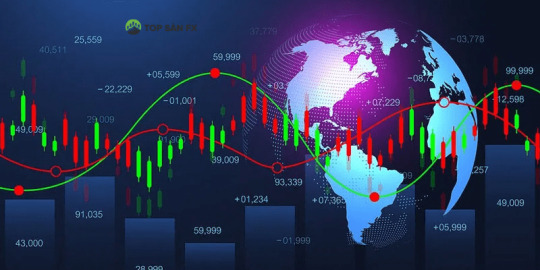#StockCharting
Explore tagged Tumblr posts
Text
Trading Tick Charts in 2025
In financial markets Trading Tick Charts, traders rely on various tools and strategies to make informed decisions, with charting being one of the most crucial aspects. Among the numerous chart types available, stand out as one of the most innovative and efficient ways to analyze market movements. As we enter 2025, understanding how tick charts work and how they can improve your trading strategies is more critical than ever before.
This guide aims to explore trading tick charts, their significance, and how traders can effectively use them in 2025. We will also discuss the concepts of trade tick chart, trading tick option chain, and the differences between trading tick call vs put, offering an in-depth analysis of how these tools interact to provide a comprehensive view of the market.
What Are Trading Tick Charts?
A trading tick chart is a type of chart used by traders to visualize market data, specifically focusing on the number of transactions (or “ticks”) that occur, rather than traditional time-based charts like minute or hourly charts. Each “tick” represents one completed trade, regardless of the time it takes. This makes tick charts uniquely suited for highly liquid markets, where volume and transaction frequency are high.
Tick charts offer real-time insights into market activity by focusing purely on price movement generated by trades. Unlike traditional time-based charts, which plot data points at fixed time intervals (e.g., every minute, hour, etc.), tick charts adjust based on the number of trades. As a result, a tick chart could feature varying time intervals for each bar depending on how frequently trades are happening.
The primary advantage of using trading tick charts lies in their ability to eliminate the “noise” that often appears in time-based charts. In time-based charts, the price movement can be irregular because a price update might happen quickly or slowly, but with tick charts, you only see actual price changes from executed trades. This results in more accurate and meaningful data that can offer sharper insights into market sentiment and trends.
By ENQUIRE in a reputable ISMT Best Stock Market Course In India (Varanasi) provides both Online & Offline courses to gain knowledge and skills in the world of trading and investment.
#TickCharts#Trading2025#DayTrading#StockMarketTips#TechnicalAnalysis#ScalpingStrategy#AlgoTrading#ChartPatterns#FinancialMarkets#TradingStrategies#FuturesTrading#MarketAnalysis#TradingTools#QuantTrading#StockCharting#DayTraderLife#TradeSmart#ModernTrading#StockTrends2025#DigitalTrading#ISMTInstitute#LearnFromISMT
0 notes
Text

"Deciphering Market Trends: Navigating the Terrain with Stock Market Indicators 📊📈 #MarketInsights #TradingStrategies"
#investing#finance#investors#stock market#trade#tradingtools#intraday trading#market insights#profit#stockcharts#economy and trade#economy#ecommerce#intraday#profitabletrades#price analysis#personal finance#income
3 notes
·
View notes
Text
Identifying Market Setups with the Help of the US Technical Analysis Report
Price Movements and Technical Reactions
Market momentum is often guided by patterns visible in price charts. The US Technical Analysis Report takes a structured approach to decode those patterns using historical price action, trend alignment, and momentum shifts. This form of analysis is especially relevant in dynamic sectors where price reactions tend to be quick and pronounced.
Rather than drawing conclusions from corporate data or economic narratives, the US Technical Analysis Report identifies repeatable technical behaviors and evaluates how market participants respond to support, resistance, and breakout patterns.
Patterns in High-Volatility Sectors
The technology segment is frequently highlighted in the US Technical Analysis Report due to its high volatility. These stocks often exhibit sharp swings driven by innovation cycles, policy updates, or shifts in consumer demand. Price patterns such as triangles, flags, and channels appear more frequently in this space and are closely monitored.
The US Technical Analysis Report examines how volume interacts with these patterns to provide clearer insights into trend continuation or reversal. Movement supported by consistent volume is often viewed as technically stronger within these high-momentum setups.
Support, Resistance, and Trend Pressure Points
Support and resistance levels offer structure to price movement and are vital areas observed within the US Technical Analysis Report. These zones represent behavioral pressure points where buyers and sellers typically react. As prices test these levels, either a bounce or breakout may occur, reflecting a shift in sentiment.
Technical tools such as the RSI and MACD are often used in conjunction with these price zones to identify the strength behind the movement. When price approaches these levels with strong momentum, a breakout or breakdown becomes more significant.
Validating Signals with Volume Patterns
Volume analysis acts as a secondary but important validation tool. The US Technical Analysis Report regularly highlights how volume behaves in relation to price changes. A trend backed by rising volume signals stronger participation and potentially more sustainable movement.
Volume also plays a role in identifying accumulation or distribution zones. Unusually high volume during a consolidation phase may suggest positioning for a breakout. The US Technical Analysis Report emphasizes these occurrences, particularly in liquid technology stocks where quick shifts often follow high-volume days.
The Role of Moving Averages in Technical Outlook
Moving averages offer a simplified lens through which broader market direction can be observed. The US Technical Analysis Report often focuses on the 50-day and 200-day moving averages, noting their influence on directional signals.
These averages help smooth out price fluctuations and are used to determine trend strength. A stock holding above its 50-day average may indicate upward pressure, while prolonged action below the 200-day average often reflects extended weakness.
Crossovers between these averages are tracked carefully in the US Technical Analysis Report, as they can signal a shift in momentum.
Using Momentum Indicators for Deeper Clarity
Momentum indicators provide a view of the energy behind a price move. Tools such as the Relative Strength Index and MACD are regularly used in the US Technical Analysis Report to detect whether a stock may be losing steam or gaining acceleration.
These indicators are often used to confirm signals from price action. For example, if a stock forms a bullish flag while the RSI is rising from oversold territory, it adds weight to the technical case. The US Technical Analysis Report combines such momentum cues with volume and pattern studies for a broader perspective.
Behavioral Structures Found in Charts
Certain chart patterns repeatedly appear across sectors, and the US Technical Analysis Report categorizes them based on reliability and historical performance. These include formations like head and shoulders, double tops, pennants, and rectangles.
These structures reflect crowd behavior—consolidation, breakout pressure, or trend fatigue. Especially in technology names, these patterns can evolve quickly due to event-driven news cycles. When paired with confirming indicators, they offer meaningful insight into potential market movement.
Integrated Indicators for Broader Direction
One of the strengths of the US Technical Analysis Report lies in its multi-layered approach. Rather than isolating a single indicator, the report brings together trendlines, averages, momentum readings, and volume shifts to paint a broader technical picture.
In sectors with elevated volatility, this alignment of signals helps filter noise and identify zones of interest. Whether a trend is continuing or facing exhaustion, multiple confirmations offer a structured way to evaluate price behavior with minimal speculation.
Technical analysis serves as a lens through which market dynamics are decoded. The US Technical Analysis Report organizes this lens by tracking trend signals, chart formations, and momentum shifts. With a strong emphasis on sectors like technology, where volatility and volume play defining roles, the US Technical Analysis Report provides a framework to observe how price behaves in real-time conditions.
0 notes
Text

Crack the candlestick code, and master the market
#CandlestickPatterns#TechnicalAnalysis#ChartPatterns#TradingSignals#StockCharts#StockMarket#TradingTips#InvestingWisely#MarketTrends#FinancialFreedom
0 notes
Text
LINEAR CHART

A linear chart represents data with equal spacing between values on the y-axis, where a move from 50 to 51 is displayed the same as a move from 100 to 101, despite the difference in percentage change.
#tradingstrategies#LinearChart#DataVisualization#ChartAnalysis#StockCharts#TradingCharts#FinancialAnalysis
0 notes
Text
🌟 WELCOME TO JV TRADE 🌟
👉 Deposit 1000 now and Get 🔥 200 Times Margin Limit 💯🌐
🔥 FIRST TIME IN INDIA - ALL YOUR FAVOURITE MARKETS IN ONE PLATFORM 🔥
💰 1000 DEPOSIT GET A BONUS OF RS 100 ON 💰

#StockMarket#Investing#TradingTips#TechnicalAnalysis#TradingCommunity#FinancialMarkets#StockPicks#TradingStrategy#MarketAnalysis#StockCharts#SwingTrading#MarketVolatility#BullMarket#BearMarket#ProfitPotential
0 notes
Text
Traders of the World: David Keller,CMT (USA) - Episódio 04
Traders of the World: David Keller,CMT (USA) – Episódio 04 Em setembro de 2023, a Trader Brasil anunciou em primeira mão que o Professor Flávio Lemos, CMT , Matheus Massari e Alan Soares serão os apresentadores de um novo podcast internacional , intitulado Traders of World. Todo mês, o programa contará com a participação de um convidado especial trader de algum lugar do mundo para falar…

View On WordPress
0 notes
Video
youtube
The Phil's Gang Investment Show, 09/01/2023
TRY OUR 10 FREE DAY WORKING INVESTOR TRIAL TODAY: https://www.philsgang.com/get-started# Phil's Gang is an innovative service that provides stock market investing education information in financial markets. Our members are taught with core essential strategies when it comes to investing by using stock charts. Our service is designed for students of all experience levels who are serious about enhancing their own investing performance.
0 notes
Text
What is Trading ?

Trading in the context of finance refers to the buying and selling of financial instruments, such as stocks, bonds, commodities, currencies, and derivatives, with the aim of making a profit. Here are the main components and types of trading:
Learn Trading course in Meerut
Types of Trading
Stock Trading: Involves buying and selling shares of publicly traded companies. Traders aim to profit from price movements in individual stocks.
Forex Trading: The exchange of currencies on the foreign exchange market. Traders speculate on the relative values of currency pairs (e.g., EUR/USD).
Commodity Trading: Involves trading physical goods like gold, oil, and agricultural products. This can be done through futures contracts, options, or spot trading.
Options and Futures Trading:
Options: Contracts that give the right, but not the obligation, to buy or sell an asset at a predetermined price before a certain date.
Futures: Contracts obligating the buyer to purchase, or the seller to sell, an asset at a predetermined future date and price.
Cryptocurrency Trading: Involves buying and selling digital currencies like Bitcoin, Ethereum, and others on various cryptocurrency exchanges.
Methods of Trading
Day Trading: Involves buying and selling financial instruments within the same trading day, closing out all positions before the market closes. Day traders often use high levels of leverage and short-term strategies.
Swing Trading: Involves holding positions for several days to weeks, aiming to profit from expected price moves or "swings."
Scalping: A strategy that involves making dozens or hundreds of trades in a single day, aiming to "scalp" small profits from each trade.
Position Trading: Involves holding positions for weeks, months, or even years, based on long-term trends and fundamental analysis.
Algorithmic Trading: Uses automated software to execute trades based on predefined criteria and algorithms. High-frequency trading (HFT) is a subset of this, involving extremely fast order execution.
Trading Strategies
Technical Analysis: Involves analyzing statistical trends from trading activity, such as price movement and volume, to identify patterns and make trading decisions.
Fundamental Analysis: Focuses on evaluating a security's intrinsic value by examining related economic, financial, and other qualitative and quantitative factors.
Sentiment Analysis: Gauges the mood of market participants through indicators, news sentiment, and other tools to predict future market movements.
Trading Platforms and Tools
Trading Platforms: Software provided by brokerage firms that allows traders to execute trades, analyze market data, and manage accounts. Examples include MetaTrader, thinkorswim, and Robinhood.
Charting Tools: Tools that provide visual representations of market data to help traders identify trends and make decisions. Examples include TradingView and StockCharts.
Order Types: Different types of orders can be placed, such as market orders, limit orders, stop-loss orders, and trailing stops, each serving different purposes in a trading strategy.
Risks and Rewards
Trading can offer significant rewards, but it also carries substantial risk. Successful trading requires knowledge, skill, discipline, and a good understanding of the markets and risk management techniques. Traders can lose substantial amounts of money, especially when leveraging positions. Therefore, proper education and preparation are crucial for anyone considering entering the trading world.
0 notes
Text
#investing#finance#investors#stock market#trade#tradingtools#intraday trading#market insights#profit#stockcharts
0 notes
Text
StockCharts
"https://stockcharts.com/ is the web's premier technical analysis platform for online investors, providing the financial charting tools, resources, education and expert market commentary you need to succeed in the market. We offer intuitive, easy-to-use charting tools for stocks, ETFs, mutual funds and more, covering multiple markets across the globe including the US, Canada, the UK and India."
0 notes
Text
Navigating the Financial World with Trading Analysis Software Services
In the complex and dynamic world of financial markets, having the right tools can make all the difference. Trading analysis software services have emerged as invaluable resources for traders, investors, and financial professionals. In this article, we'll explore the significance of trading analysis software services, what they offer, and how they empower individuals and organizations in the financial sector.
Understanding Trading Analysis Software Services
Trading analysis software services encompass a wide range of digital tools and platforms designed to assist individuals and businesses in making informed decisions in the financial markets. These services utilize cutting-edge technology and data analysis techniques to provide insights, predictions, and real-time information that can be crucial for success in trading, investing, and financial planning.
Key Components of Trading Analysis Software Services
Data Aggregation: These services gather vast amounts of financial data from various sources, including stock exchanges, news feeds, and economic indicators.
Analysis Tools: Sophisticated algorithms and analytical tools are used to interpret and process the collected data, enabling users to identify patterns, trends, and potential trading opportunities.
Charting and Visualization: Interactive charts and graphs make it easier to understand market movements and patterns, helping traders make informed decisions.
Technical and Fundamental Analysis: Trading analysis software services often provide both technical and fundamental analysis, allowing users to examine price movements, indicators, and economic data.
Backtesting and Simulation: Users can test trading strategies and simulate market conditions to evaluate their potential success.
Real-Time Alerts: Many services offer real-time alerts, notifying users of significant market events or changes that may affect their portfolios.
Benefits of Trading Analysis Software Services
Efficiency: These services streamline the process of data analysis, saving users time and effort. They can quickly access information and insights that would be time-consuming to gather manually.
Informed Decision-Making: Users can make well-informed decisions based on accurate data and analysis, reducing the risk of impulsive or uninformed trading.
Risk Management: Many services offer risk assessment tools that help users manage their portfolios and minimize potential losses.
Accessibility: Trading analysis software services are typically accessible from desktops, laptops, and mobile devices, allowing users to stay connected to the markets regardless of their location.
Education and Learning: These services often provide educational resources, helping both novice and experienced traders enhance their knowledge and skills.
Types of Trading Analysis Software Services
Trading analysis software services are available in various forms to cater to different needs and preferences:
Trading Platforms: These are comprehensive software solutions that provide access to multiple financial markets, including stocks, bonds, forex, and cryptocurrencies. Examples include MetaTrader, thinkorswim, and TradingView.
Charting and Technical Analysis Tools: These services focus on providing detailed charts and technical analysis features. Traders often use them to identify trends and trading signals. Notable options include TradingView, StockCharts, and NinjaTrader.
Algorithmic Trading Platforms: These platforms are designed for algorithmic or automated trading, allowing users to develop, test, and execute trading strategies using code. Examples include MetaTrader and QuantConnect.
Social Trading Platforms: These platforms combine trading with social networking, enabling users to follow and copy the trades of experienced traders. eToro and ZuluTrade are popular examples.
News and Data Services: These services focus on delivering real-time financial news, data, and analysis. Bloomberg Terminal and Thomson Reuters Eikon are prominent in this category.
Challenges and Considerations
While trading analysis software services offer numerous advantages, there are also some challenges and considerations to keep in mind:
Cost: Many of these services come with subscription fees or usage charges, which can add up over time. Users should weigh the cost against the potential benefits.
Learning Curve: Some services can be complex and require a learning curve. Users may need time to become proficient in using all the available tools and features.
Data Accuracy: The accuracy of the data and analysis provided by these services is crucial. Users should ensure that the service they choose relies on trustworthy data sources.
Security and Privacy: Users must consider the security of their personal and financial data when using trading analysis software services, especially when dealing with online platforms.
Market Volatility: Even with advanced analysis tools, the financial markets can be highly volatile and unpredictable. Users should be aware that there are no guarantees of success in trading.
The Role of Trading Analysis Software in the Financial World
Trading analysis software services have become integral to the financial world in various ways:
Professional Traders: Professional traders and financial institutions rely on these services to execute complex strategies and manage their portfolios efficiently.
Individual Investors: Retail investors use trading analysis software to make informed investment decisions and manage their own portfolios.
Financial Advisors: Financial advisors leverage these tools to provide more comprehensive and data-driven advice to their clients.
Educational Resources: Many trading analysis software services offer educational content, webinars, and tutorials, contributing to the education of traders and investors.
Market Research: Researchers and analysts use these services to gather data, analyze trends, and produce reports on financial markets.
The Future of Trading Analysis Software Services
The future of trading analysis software services looks promising. Advancements in technology, including artificial intelligence and machine learning, are expected to further enhance the accuracy and capabilities of these tools. Additionally, the integration of blockchain technology and the growth of cryptocurrency markets have expanded the scope of trading analysis software services.
As the financial world continues to evolve, trading analysis software services will play a pivotal role in helping individuals and organizations navigate the complex and ever-changing landscape of global markets. Whether you are a seasoned trader or a newcomer to the world of finance, these tools provide the data, insights, and resources you need to make informed decisions and maximize your potential for success.
For More Info:-
web scraping services provider
web scraping service provider
paper trading softwares company
best technical analysis software service
1 note
·
View note
Text
Future-Proofing Finance Education: Tech Tools Every Business Student Should Embrace
The marriage of finance and technology has ushered in a new era of possibilities, transforming how business students learn and engage with the financial world. To thrive in this evolving landscape, students must equip themselves with the essential tech tools shaping finance's future. These tools provide a deeper understanding of complex financial concepts and offer hands-on experience with the tools that professionals use to navigate the intricate realm of finance. This article explores the tech tools every business student should embrace to future-proof their finance education.
Wealthsimple: Demystifying Investing
Investing is a fundamental skill in the finance world, and Wealthsimple simplifies the process for students. This robo-advisory platform offers a user-friendly way to start investing, helping students learn about portfolio construction, risk management, and long-term wealth accumulation through hands-on experience.
R Programming: Analytics Powerhouse
In the era of data-driven decision-making, learning a programming language like R can be a game-changer. With its rich analytics capabilities, R allows business students to analyze financial data, create interactive visualizations, and develop predictive models, enhancing their ability to derive insights and make informed financial decisions.
NerdWallet: Personal Finance Education
Understanding personal finance is essential for every business student's financial well-being. NerdWallet offers a wealth of educational resources on topics like budgeting, credit management, and investment strategies. Students can make informed decisions about their financial futures by arming themselves with personal finance knowledge.
QuantConnect: Algorithmic Trading Playground
QuantConnect provides a sandbox for experimenting with trading strategies for students intrigued by algorithmic trading. With access to historical and real-time data, students can develop, backtest, and deploy trading algorithms, gaining a deep understanding of quantitative finance principles.
LinkedIn Learning: Lifelong Learning Hub
Finance is a field that evolves rapidly, requiring continuous learning. LinkedIn Learning offers diverse finance courses, from corporate finance fundamentals to blockchain technology. Business students can stay ahead of industry trends and acquire new skills to remain competitive in the ever-changing financial landscape.
MoneyMap: Visual Financial Planning
MoneyMap is a dynamic tool that allows students to create visual financial plans, helping them set goals, track expenses, and plan for the future. By visualizing their financial journey, students can develop effective strategies for managing their finances during their studies and beyond.
Wolfram Alpha: Math for Finance Made Easy
Mathematics underpins much of finance, and Wolfram Alpha is a powerful tool for solving complex mathematical equations and conducting financial calculations. Business students can leverage this tool to enhance their understanding of financial concepts and hone their analytical skills.
StockCharts: Charting Your Financial Insights
Charts are essential for visualizing financial trends and patterns. StockCharts provides a platform for creating and customizing charts, enabling business students to analyze stock performance, technical indicators, and market trends, fostering a more profound comprehension of financial markets.
TD Ameritrade's thinkorswim: Virtual Trading Playground
Practice makes perfect, especially when it comes to trading. TD Ameritrade's thinkorswim offers a virtual trading environment where students can test strategies, execute trades, and navigate real-time market conditions without risking natural capital, all while gaining practical experience in financial markets.
FinTech Sandbox: Exploring Emerging Technologies
The finance industry is at the forefront of technological innovation. FinTech Sandbox provides access to real-world financial data and tools, allowing business students to explore and experiment with emerging technologies such as blockchain, AI, and predictive analytics, gaining insights into the future of finance.
As finance and technology continue to converge, business students who embrace these essential tech tools position themselves as forward-thinking leaders. Each tool equips students with skills vital for success in the evolving finance landscape, from algorithmic trading to personal finance education and analytics to continuous learning. By integrating these tech tools into their educational journey, business students become adaptable, tech-savvy professionals who can navigate the complexities of finance with confidence and innovation.
0 notes
Link
0 notes
Text
📊💹Trading Stocks is Like Riding a Rollercoaster. But hey, at Least it's Never Boring!💰🤩
📈 Grow your Wealth and increase your income level……

#highsandslows#stockmarketlife#diversificationiskey#investingtips#StockMarket#Investing#TradingTips#TechnicalAnalysis#TradingCommunity#FinancialMarkets#StockPicks#TradingStrategy#MarketAnalysis#StockCharts
0 notes
Text
Phân tích XAU/USD và WTI/USD ngày 26/06/2023
XAU/USD Vào tuần trước giá vàng đã được kéo lên, nhưng vào cuối phiên thì giá vàng lại giảm và đóng cửa gần mức thấp. Do đó, khả năng xu hướng giảm tiếp tục duy trì là khá cao. Nếu trader nào đã bán khống thì nên giữ lệnh và dừng đặt lỗ phía trên 1990$ và đợi tiếp xem sao. Mục tiêu giá ước tính theo stockcharts là 1820. Biểu đồ XAU/USD WTI/USD Hiện giờ giá dầu vẫn đang có thiên hướng biến động…

View On WordPress
0 notes